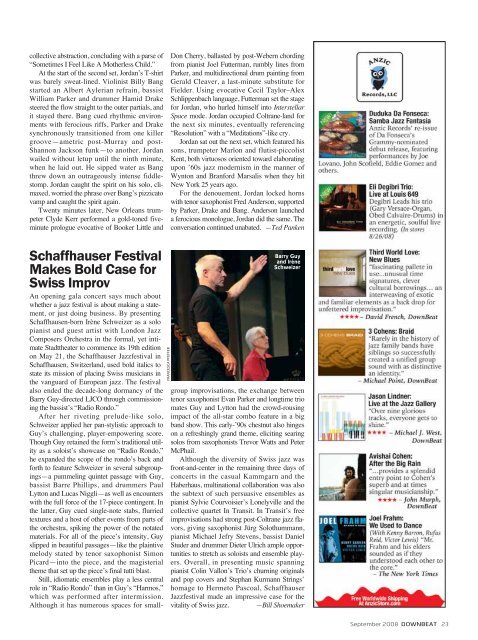Download - Downbeat
Download - Downbeat
Download - Downbeat
Create successful ePaper yourself
Turn your PDF publications into a flip-book with our unique Google optimized e-Paper software.
collective abstraction, concluding with a parse of<br />
“Sometimes I Feel Like A Motherless Child.”<br />
At the start of the second set, Jordan’s T-shirt<br />
was barely sweat-lined. Violinist Billy Bang<br />
started an Albert Aylerian refrain, bassist<br />
William Parker and drummer Hamid Drake<br />
steered the flow straight to the outer partials, and<br />
it stayed there. Bang cued rhythmic environments<br />
with ferocious riffs, Parker and Drake<br />
synchronously transitioned from one killer<br />
groove—ametric post-Murray and post-<br />
Shannon Jackson funk—to another. Jordan<br />
wailed without letup until the ninth minute,<br />
when he laid out. He sipped water as Bang<br />
threw down an outrageously intense fiddlestomp.<br />
Jordan caught the spirit on his solo, climaxed,<br />
worried the phrase over Bang’s pizzicato<br />
vamp and caught the spirit again.<br />
Twenty minutes later, New Orleans trumpeter<br />
Clyde Kerr performed a gold-toned fiveminute<br />
prologue evocative of Booker Little and<br />
Don Cherry, ballasted by post-Webern chording<br />
from pianist Joel Futterman, rumbly lines from<br />
Parker, and multidirectional drum painting from<br />
Gerald Cleaver, a last-minute substitute for<br />
Fielder. Using evocative Cecil Taylor–Alex<br />
Schlippenbach language, Futterman set the stage<br />
for Jordan, who hurled himself into Interstellar<br />
Space mode. Jordan occupied Coltrane-land for<br />
the next six minutes, eventually referencing<br />
“Resolution” with a “Meditations”-like cry.<br />
Jordan sat out the next set, which featured his<br />
sons, trumpeter Marlon and flutist-piccolist<br />
Kent, both virtuosos oriented toward elaborating<br />
upon ’60s jazz modernism in the manner of<br />
Wynton and Branford Marsalis when they hit<br />
New York 25 years ago.<br />
For the denouement, Jordan locked horns<br />
with tenor saxophonist Fred Anderson, supported<br />
by Parker, Drake and Bang. Anderson launched<br />
a ferocious monologue, Jordan did the same. The<br />
conversation continued unabated. —Ted Panken<br />
Schaffhauser Festival<br />
Makes Bold Case for<br />
Swiss Improv<br />
FRANCESCA PFEFFER<br />
Barry Guy<br />
and Irène<br />
Schweizer<br />
An opening gala concert says much about<br />
whether a jazz festival is about making a statement,<br />
or just doing business. By presenting<br />
Schaffhausen-born Irène Schweizer as a solo<br />
pianist and guest artist with London Jazz<br />
Composers Orchestra in the formal, yet intimate<br />
Stadttheater to commence its 19th edition<br />
on May 21, the Schaffhauser Jazzfestival in<br />
Schaffhausen, Switzerland, used bold italics to<br />
state its mission of placing Swiss musicians in<br />
the vanguard of European jazz. The festival<br />
also ended the decade-long dormancy of the<br />
Barry Guy-directed LJCO through commissioning<br />
the bassist’s “Radio Rondo.”<br />
After her riveting prelude-like solo,<br />
Schweizer applied her pan-stylistic approach to<br />
Guy’s challenging, player-empowering score.<br />
Though Guy retained the form’s traditional utility<br />
as a soloist’s showcase on “Radio Rondo,”<br />
he expanded the scope of the rondo’s back and<br />
forth to feature Schweizer in several subgroupings—a<br />
pummeling quintet passage with Guy,<br />
bassist Barre Phillips, and drummers Paul<br />
Lytton and Lucas Niggli—as well as encounters<br />
with the full force of the 17-piece contingent. In<br />
the latter, Guy cued single-note stabs, flurried<br />
textures and a host of other events from parts of<br />
the orchestra, spiking the power of the notated<br />
materials. For all of the piece’s intensity, Guy<br />
slipped in beautiful passages—like the plaintive<br />
melody stated by tenor saxophonist Simon<br />
Picard—into the piece, and the magisterial<br />
theme that set up the piece’s final tutti blast.<br />
Still, idiomatic ensembles play a less central<br />
role in “Radio Rondo” than in Guy’s “Harmos,”<br />
which was performed after intermission.<br />
Although it has numerous spaces for smallgroup<br />
improvisations, the exchange between<br />
tenor saxophonist Evan Parker and longtime trio<br />
mates Guy and Lytton had the crowd-rousing<br />
impact of the all-star combo feature in a big<br />
band show. This early-’90s chestnut also hinges<br />
on a refreshingly grand theme, eliciting searing<br />
solos from saxophonists Trevor Watts and Peter<br />
McPhail.<br />
Although the diversity of Swiss jazz was<br />
front-and-center in the remaining three days of<br />
concerts in the casual Kammgarn and the<br />
Haberhaus, multinational collaboration was also<br />
the subtext of such persuasive ensembles as<br />
pianist Sylvie Courvoisier’s Lonelyville and the<br />
collective quartet In Transit. In Transit’s free<br />
improvisations had strong post-Coltrane jazz flavors,<br />
giving saxophonist Jürg Solothummann,<br />
pianist Michael Jefry Stevens, bassist Daniel<br />
Studer and drummer Dieter Ulrich ample opportunities<br />
to stretch as soloists and ensemble players.<br />
Overall, in presenting music spanning<br />
pianist Colin Vallon’s Trio’s churning originals<br />
and pop covers and Stephan Kurmann Strings’<br />
homage to Hermeto Pascoal, Schaffhauser<br />
Jazzfestival made an impressive case for the<br />
vitality of Swiss jazz. —Bill Shoemaker<br />
September 2008 DOWNBEAT 23
















